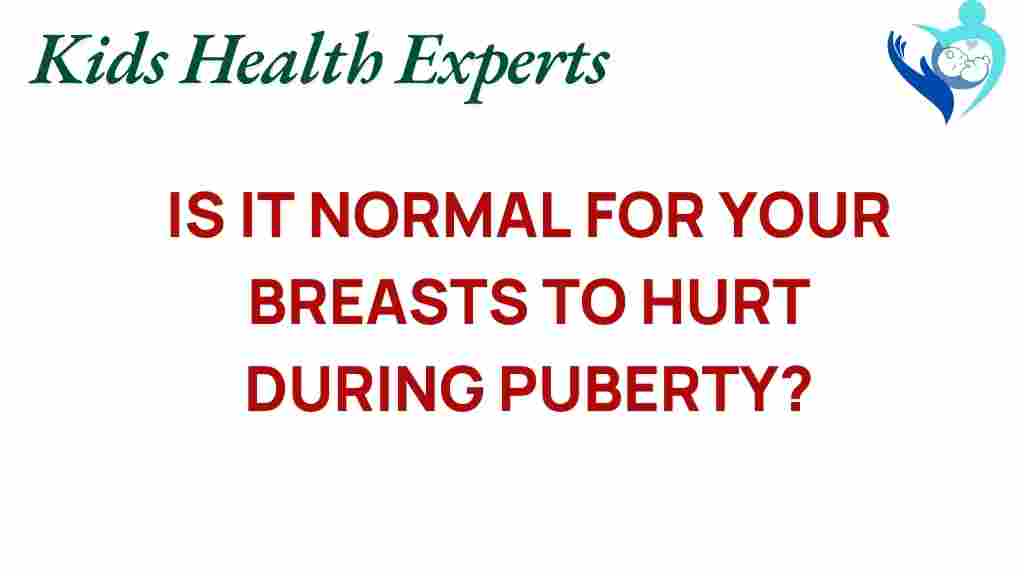Understanding Breast Pain During Puberty: What’s Normal?
Puberty is a transformative time in an adolescent’s life, marked by significant physical and emotional changes. Among these changes, breast development can often lead to discomfort or pain, commonly referred to as breast pain. Understanding what constitutes normal breast pain during puberty is crucial for adolescent health and women’s health overall. In this article, we will explore the causes of breast pain, how it relates to hormonal changes, common symptoms, and effective pain management strategies.
The Basics of Breast Development
During puberty, typically between the ages of 8 and 13, girls undergo numerous body changes as they transition into womanhood. The breasts begin to grow due to hormonal changes, primarily the increase in estrogen levels. This development can lead to a variety of sensations, including tenderness and discomfort.
- Hormonal Changes: The surge in hormones is responsible for initiating breast development.
- Development Stages: Breast development is often categorized into stages, starting with breast buds and progressing to full maturity.
- Body Changes: Alongside breast growth, other physical and emotional changes occur, including the onset of menstruation.
What Causes Breast Pain During Puberty?
Understanding the causes of breast pain is essential for recognizing what is normal during puberty. Here are some common factors:
- Hormonal Fluctuations: Changes in estrogen and progesterone levels can lead to tenderness.
- Growth Spurts: Rapid breast growth can stretch the tissue and cause discomfort.
- Menstrual Cycle: Many adolescents experience breast pain related to their menstrual cycle, often in the days leading up to their period.
- Physical Activity: Activities such as sports can sometimes lead to soreness.
- Ill-Fitting Bras: Wearing a bra that does not provide adequate support can contribute to pain.
Common Symptoms of Breast Pain
Breast pain during puberty can manifest in various ways. Here are some common symptoms to be aware of:
- Tenderness: Breasts may feel sore to the touch.
- Throbbing or Aching: A dull ache may be felt in the breast tissue.
- Swelling: Breasts may appear fuller or mildly swollen.
- Localized Pain: Some girls experience pain in specific areas of the breast.
When is Breast Pain Normal?
While breast pain can be concerning, it is important to differentiate between normal and abnormal symptoms.
- Normal: Mild to moderate pain during breast development is common and usually resolves over time.
- Concerning: Severe pain, pain that persists beyond a few cycles, or pain accompanied by other unusual symptoms (like lumps or discharge) should be evaluated by a healthcare professional.
Step-by-Step Guide to Managing Breast Pain
Managing breast pain during puberty can involve several strategies. Here’s a step-by-step guide:
1. Wear a Supportive Bra
Choosing the right bra can significantly alleviate discomfort. Look for:
- Supportive underwire bras
- Sports bras during physical activities
- Bras that fit properly and offer sufficient coverage
2. Use Pain Relief Techniques
Over-the-counter medications, such as ibuprofen or acetaminophen, can help manage pain. Additionally:
- Apply a warm or cold compress to the breasts.
- Engage in relaxation techniques such as deep breathing or yoga to alleviate overall tension.
3. Monitor Your Cycle
Understanding your menstrual cycle can help anticipate when breast pain may occur. Keeping a journal can be beneficial:
- Note down when symptoms occur.
- Track any lifestyle changes, such as diet or stress levels.
4. Stay Active and Healthy
Regular physical activity can help reduce overall body tension, which may alleviate breast pain. Additionally:
- Maintain a balanced diet rich in fruits, vegetables, and whole grains.
- Stay hydrated and limit caffeine and salt intake, which may exacerbate symptoms.
Common Troubleshooting Tips
If you or someone you know is experiencing breast pain during puberty, consider the following troubleshooting tips:
- Evaluate your bra size: Consider getting fitted for a bra to ensure proper support.
- Assess physical activity: Reduce high-impact activities that may aggravate breast pain.
- Keep a symptom diary: Documenting pain frequency and intensity can help identify patterns and triggers.
When to Seek Medical Advice
Though breast pain is often a normal part of puberty, certain situations warrant medical attention:
- If pain is severe or debilitating.
- If lumps or unusual changes in breast tissue are noticed.
- If there is any discharge from the nipple.
- If pain persists beyond the typical age of puberty or significantly affects daily life.
Consulting with a healthcare provider can help ensure that any underlying issues are addressed and provide peace of mind.
Conclusion
Understanding breast pain during puberty is an essential aspect of adolescent health and development. While breast pain is commonly associated with hormonal changes and growth, it is vital to recognize the differences between normal and concerning symptoms. Through proper pain management techniques, supportive measures, and awareness of one’s body, most adolescents can navigate this phase with minimal discomfort. If ever in doubt, seeking guidance from a healthcare professional is always the best course of action. For more information on adolescent health, you can visit this resource.
By understanding and addressing the common symptoms and causes of breast pain during puberty, young individuals can foster a sense of confidence and awareness about their bodies, ultimately promoting better women’s health in the future.
This article is in the category Conditions and created by KidsHealthExperts Team
